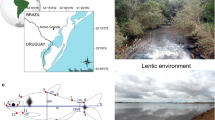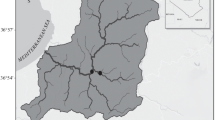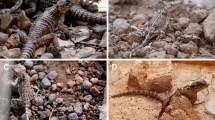Abstract
In tropical regions, limestone aquatic environments of the Caatinga are more prone to hypoxia due to water heating, long drought periods, and high rates of organic decomposition. To circumvent this limitation, some fish species have developed different adaptations to maximize oxygen capture. These adaptations usually involve the capture of oxygen on surface layers, a mechanism known as aquatic surface respiration (ASR). In Characiformes, adaptations for ASR are related to the development of labial protuberances, which may appear within a period of up to 24 h. Some species of the genus Triportheus present barbels on the lower lip, a remarkable adaptation that assist in ASR. One of these is T. signatus from the Caatinga river basins that present intermittent flow regime. This research aimed to investigate the morphology and histological organization of the barbels developed by T. signatus in a lentic environments. Specimens from semiarid drainages belonging to the Mid-Northeastern Caatinga, Maranhão-Piauí, and São Francisco ecoregions were examined. Transverse and longitudinal histological sections of different portions of the barbels were made. The histological organization of the structure shows that the barbel is very vascularized, suggesting a modification to improve gas exchange. The superficial vessels present hemosiderin extravasation, representing hemorrhagic areas, probably related to the rapid formation of the structure, indicating the fast response of this species to environmental modifications. These results suggest that the barbels in T. signatus might both assist in directing superficial water to the mouth, as well as in oxygen absorption, however this latter assumption should be tested through experimental studies.





Similar content being viewed by others
References
Adams SM (2002) Biological indicators of aquatic ecosystem stress. Am Fish Soc 3:104–112
Affonso EG, Rantin FT (2005) Respiratory responses of the air-breathing fish Hoplosternum littorale to hypoxia and hydrogen sulfide. Comp Biochem Physiol Part C: Toxicol Pharmacol 141(3):275–280
Albert JS, Petry PA, Reis RE (2011) Major biogeographic and phylogenetic patterns. In: Albert JS, Reis ER (eds) Historical biogeography of Neotropical freshwater fishes. Berkeley University of California Press, p.21–58
Albuquerque UP, Araújo EL, El-Deir ACA, de Lima ALA, Souto A, Bezerra BM, ... de Moura GJB (2012) Caatinga Revisited: Ecology and Conservation of an Important Seasonal Dry Forest. The Scientific World Journal 2012:1-18 DOI:10.1100/2012/205182
Buckup PA, Menezes NA, Ghazzi MSA (2007) Catálogo das espécies de peixes de água doce do Brasil (Vol. 1). Rio de Janeiro: Museu Nacional, p. 1-195
Carolsfield J, Harvey B, Ross C, Baer A (2004) Migratory fishes of South America: biology, fisheries, and conservation status. World Fisheries Trust/Banque mondiale/CRDI. 380p
Costa WJEM (2014) Six new species of seasonal killifishes of the genus Cynolebias from the São Francisco River basin, Brazilian Caatinga, with notes of C. porosus (Cyprinodontiformes: Rivulidae). Ichthyol Explor Freshw 25(1):79–96
Costa WJEM, Amorim PF, Braganca PH (2014) Species limits and phylogenetic relationships of red-finned cryptic species of the seasonal killifish genus Hypsolebias from the Brazilian semi-arid Caatinga (Teleostei: Cyprinodontiformes: Rivulidae). J Zool Syst Evol Res 52(1):52–58. https://doi.org/10.1111/jzs.12041
Fink WL, Weitzman SH (1974) The so-called cheirodontin characids of Central America, with descriptions of two new species (Pisces: Characidae). Smithson Contr Zool 172:1–46
Galina AB, Hahn NS (2004) Atividade de forrageamento de Triportheus spp. (Characidae, Triporheinae) utilizada como ferramenta de amostragem da entomofauna, na área do reservatório de Manso, MT. Revista Brasileira de Zoociências 6(1):81–92
Gama CS, Caramaschi EP (2001) Alimentação de Triportheus albus (Cope 1971) (Osteichthyes, Characiformes) face à implantação do AHE Serra da Mesa no rio Tocantins. Revista Brasileira de Zoociências 3(2):159–170
Genten F, Terwinghe E, Danguy A (2009) Atlas of fish histology. Science Publishers, New York, p 215
Glover CN, Bucking C, Wood CM (2013) The skin of fish as a transport epithelium: a review. J Comp Physiol B 183(7):877–891
Graham JB (1997) Air-breathing fishes: evolution, diversity and adaptation. Academic Press, Cambridge, p 299
Gurgel-Lourenço RC, Rodrigues-Filho CADS, Angelini R, Garcez DS, Sánchez-Botero JI (2015) On the relation amongst limnological factors and fish abundance in reservoirs at semiarid region. Acta Limnologica Brasiliensia, 27(1), 24-38. DOI: 10.1590/S2179-975X2414
Kramer DL, Mehegan JP (1981) Aquatic surface respiration, an adaptive response to hypoxia in the guppy, Poecilia reticulata (Pisces, Poeciliidae). Environ Biol Fish 6(3–4):299–313 https://doi.org/10.1007/BF00005759
Kramer DL, McClure M (1982) Aquatic surface respiration, a widespread adaptation to hypoxia in tropical freshwater fishes. Environmental Biology of Fishes 7 (1):47-55
Langeani F, Buckup PA, Malabarba LR, Py-Daniel LHR, Lucena CAS, Rosa RS, Zuanon JAS, Lucena ZMS, Britto MR, Oyakawa OT, Gomes-Filho G (2009) Peixes de água Doce. In: Rocha RM, Boeger WAP (eds) Estado da arte e perspectivas para a Zoologia no Brasil. Curitiba, Editora da UFPR, pp 211–230
Lima SMQ, Ramos TPA, da Silva MJ, Rosa RS (2017) Diversity, distribution, and conservation of the Caatinga fishes: advances and challenges. In: Silva JMC, Leal IR, Tabarelli M (eds) Caatinga. Springer, Cham. https://doi.org/10.1007/978-3-319-68339-3_4
Lowe-McConnell RH (1987) Ecological studies in tropical fish communities. Cambridge tropical biology series. Cambridge University Press, Cambridge, p 382
Malabarba MC (2004) Revision of the Neotropical genus Triportheus cope, 1872 (Characiformes: Characidae). Neotrop Ichthyol 2(4):167–204
Medeiros ESF, Arthington AH (2008) Diel variation in food intake and diet composition of three native fish species in floodplain lagoons of the Macintyre River, Australia. J Fish Biol 73:1024–1032
Mendes LB, Borges JAT, Silva MJ, Ramos RTC, Medeiros ESF (2011) Food habits of Triportheus signatus (Teleostei, Characidae) in a Brazilian semi-arid intermittent river. Revista Brasileira de Zoociências 13(1, 2, 3):59–71
Mumford S, Heidel J, Smith C, Morrison J, Macconnell B, Blazer V (2007) Fish histology and histopathology. US Fish and Wildlife National Conservation Training Center, Amerika Serikat. 357p
Pinto GA, Rocha AAF, Santos NCL, Medeiros TN, Severi W (2011) Variação sazonal na dieta de Triportheus guentheri (Garman, 1890) (Actinopterygii: Characidae), no reservatório de Sobradinho, rio São Francisco, BA. Bol Inst Pesca 37(3):295–306
Rantin FT, Guerra CDR, Kalinin AL, Glass ML (1998) The influence of aquatic surface respiration (ASR) on cardio-respiratory function of the serrasalmid fish Piaractus mesopotamicus. Comparative Biochemistry and Physiology Part A: Molecular & Integrative Physiology 119 (4):991-997
Reis RE, Kullander SO, Ferraris CJ (2003) Check list of the freshwater fishes of South and Central America. Edipucrs, Porto Alegre
Saint-Paul U, Soares GM (1987) Diurnal distribution and behavioral responses of fishes to extreme hypoxia in an Amazon floodplain lake. Environ Biol Fish 20(2):91–104
Scarabotti PA, Julieta Parma M, López JA, Ghirardi R (2009) Dermal lip protuberances associated with aquatic surface respiration in juveniles of the piscivorous characid Salminus brasiliensis (Actinopterygii: Characidae). Neotrop Ichthyol 7(3):459–464
Scarabotti PA, López JA, Ghirardi R, Parma MJ (2011) Morphological plasticity associated with environmental hypoxia in characiform fishes from neotropical floodplain lakes. Environ Biol Fish 92:391–402
Soares MGM, Menezes NA, Junk WJ (2006) Adaptations of fish species to oxygen depletion in a central Amazonian floodplain lake. Hydrobiologia 568:353–367
Tolosa EMC, Rodrigues CJ, Behmer OA, Neto AGF (2003) Manual de técnicas para Histologia normal e patológica. Ed Manole. São Paulo. 2° ed. 331p
Winemiller KO, Montoya JV, Roelke DL, Layman CA, Cotner JB (2006) Seasonally varying impact of detritivorous fishes on the benthic ecology of a tropical floodplain river. Journal of the North American Benthological Society, 25(1), 250-262. DOI: 10.1899/0887-3593(2006)25[250:SVIODF]2.0.CO;2
Winemiller KO (1989) Development of dermal lip protuberances for aquatic surface respiration in south American characid fishes. Copeia 1989:382–390
Yamamoto KC, Soares MGM, Freitas CEC (2004) Alimentação de Triportheus angulatus (Spix & Agassiz, 1829) no lago Camaleão, Manaus, AM, Brasil. Acta Amazon 34(4):653–659
Zhu CD, Wang ZH, Yan B (2013) Strategies for hypoxia adaptation in fish species: a review. Journal of Comparative Physiology B, 183(8), 1005-1013. DOI:10.1007/s00360-013-0762-3
Acknowledgements
We thank the teams of the LISE (Laboratório de Ictiologia Sistemática e Evolutiva) and the GEEFAA (Grupo de Estudos de Ecologia e Fisiologia de Animais Aquáticos) of UFRN, who participated in the collections, as well as the technicians of the Histotechnical Laboratory for the preparation of the microscope slides. Collections were made under permit #32656-1/2012 MMA/ICMBio/SISBIO from Ministério Brasileiro do Meio Ambiente/Instituto Chico Mendes de Conservação da Biodiversidade/Sistema de Autorização e Informação em Biodiversidade. This study was supported by CNPq/ICMBio (Conselho Nacional de Desenvolvimento Científico e Tecnológico; process #552086/2011-8). This study was financed in part by the Coordenação de Aperfeiçoamento de Pessoal de Nível Superior - Brasil (CAPES) - Finance Code 001. SMQL is supported by Conselho Nacional de Desenvolvimento Científico e Tecnológico (CNPq) Grant (#313644/2018-7).
Author information
Authors and Affiliations
Corresponding author
Additional information
Publisher’s note
Springer Nature remains neutral with regard to jurisdictional claims in published maps and institutional affiliations.
Rights and permissions
About this article
Cite this article
de Freitas Barros Neto, L., Frigo, R.G., Gavilan, S.A. et al. Barbel development associated to aquatic surface respiration in Triportheus signatus (Characiformes: Triportheidae) from the semiarid Caatinga rivers. Environ Biol Fish 103, 89–98 (2020). https://doi.org/10.1007/s10641-019-00935-x
Received:
Accepted:
Published:
Issue Date:
DOI: https://doi.org/10.1007/s10641-019-00935-x




